
6.6. EXERCISES 143
3. Suppose A∈L (V,V ) where V is a finite dimensional vector space and suppose p(λ )is the minimum polynomial. Say p(λ ) = λ
m + am−1λm−1 + · · ·+ a1λ + a0. If A is
one to one, show that it is onto and also that A−1 ∈L (V,V ). In this case, explainwhy a0 ̸= 0. In this case, give a formula for A−1 as a polynomial in A.
4. Let A =
(0 −21 3
). Its minimum polynomial is λ
2− 3λ + 2. Find A10 exactly.
Hint: You can do long division and get λ10 = l (λ )
(λ
2−3λ +2)+1023λ −1022.
5. Suppose A ∈L (V,V ) and it has minimum polynomial p(λ ) which has degree m. Itis desired to compute An for n large. Show that it is possible to obtain An in terms ofa polynomial in A of degree less than m.
6. Determine whether the following matrices are diagonalizable. Assume the field ofscalars is C.
(a)
1 1 1−1 2 10 1 1
(b)
( √2+1 1−1
√2−1
)
(c)
(a+1 1−1 a−1
)where a ∈ R
(d)
1 1 −12 1 −10 1 2
(e)
2 1 0−1 0 02 2 1
7. The situation for diagonalizability was presented for the situation in which the min-imum polynomial factors completely as a product of linear factors since this is cer-tainly the case of most interest, including C. What if the minimum polynomial doesnot split? Is there a theorem available that will allow one to conclude that the matrixis diagonalizable in a splitting field, possibly larger than the given field? It is a rea-sonable question because the assumption that p(λ ) , p′ (λ ) are relatively prime maybe determined without factoring the polynomials and involves only computations in-volving the given field F. If you enlarge the field, what happens to the minimumpolynomial? Does it stay the same or does it change? Remember, the matrix hasentries all in the smaller field F while a splitting field is G larger than F, but you candetermine the minimum polynomial using row operations on vectors in Fn2
.
8. Suppose V is a finite dimensional vector space and suppose N ∈L (V,V ) satisfiesNm = 0 for some m≥ 1. Show that the only eigenvalue is 0.
9. Suppose V is an n dimensional vector space and suppose β is a basis for V. Considerthe map µI : V →V given by µIv = µv. What is the matrix of this map with respectto the basis β? Hint: You should find that it is µ times the identity matrix whose i jth
entry is δ i j which is 1 if i = j and 0 if i ̸= j. Thus the i jth entry of this matrix will beµδ i j.
10. In the case that the minimum polynomial factors, which was discussed above, wehad
V = ker(L−µ1I)k1 ⊕·· ·⊕ker(L−µ pI
)kp